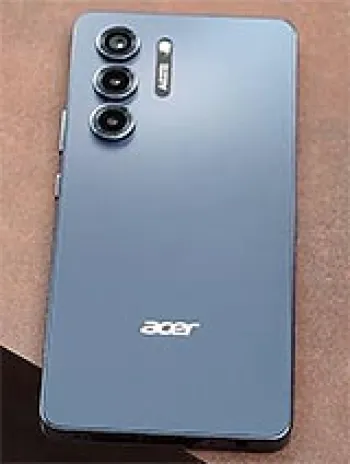
Overview
The Acer Liquid X1, announced in June 2014 and released in September of the same year, represents a one-time player in the mid-range smartphone market. Known for its balance of performance and cost, the discontinued Liquid X1 came equipped with a range of features designed to appeal to budget-conscious consumers seeking reliable functionality.
Design and Build
Acer Liquid X1 features a sleek design with dimensions of 153.3 x 80.4 x 8.5 mm, making it comfortably slim and ergonomic. Weighing in at 164 grams, it offers a solid feel without being cumbersome. Crafted to fit comfortably in hand, the Liquid X1 housed a micro-SIM slot within a stylish body available in colors such as Graphite Black and Wine Red.
Display
The device sported a 5.7-inch IPS LCD screen with a resolution of 720 x 1280 pixels, resulting in a pixel density of approximately 258 ppi. While not the most high-definition display by modern standards, it provided a respectable screen-to-body ratio of around 72.7% and was protected by Corning Gorilla Glass 3, ensuring durability against everyday scratches and impacts.
Platform and Performance
Under the hood, the Acer Liquid X1 ran on Android 4.4.2 KitKat, powered by the Mediatek MT6592 chipset built using a 28nm manufacturing process. This octa-core CPU clocked at 1.7 GHz utilized Cortex-A7 architecture and was paired with a Mali-450MP4 GPU, making it suitable for handling daily tasks and providing a moderate level of gaming capability.
Memory and Storage
In terms of storage, the Liquid X1 was equipped with 16GB of internal memory, which could be expanded via a dedicated microSDHC slot, providing flexibility for users to store their multimedia content and applications. It also featured 2GB of RAM, which was adequate for the operating system and basic multitasking needs during its time.
Camera Features
The camera setup on the Acer Liquid X1 included a single 13 MP main camera with autofocus capabilities, accompanied by an LED flash. This setup was capable of recording video at 1080p at 30fps, making it a decent choice for capturing everyday moments. The front camera was a basic 2 MP shooter, primarily used for video calls and selfie shots in adequate lighting conditions.
Sound and Connectivity
Audio needs were addressed with a standard loudspeaker and a 3.5mm headphone jack, catering to traditional users preferring wired audio solutions. The connectivity suite encompassed essential features like Wi-Fi 802.11 b/g/n, Bluetooth 4.0 with A2DP, GPS for reliable navigation, and FM radio, ensuring offline entertainment. The device, however, did not support NFC technology.
Network Compatibility
The Liquid X1 supported multiple network bands, including GSM, HSPA, and LTE, allowing for flexible use across various regions. It included 2G, 3G bands (HSDPA 900/2100), and 4G LTE bands 3 and 7, providing versatility for users who travel frequently.
Sensors and Additional Features
To enhance user experience, the phone included essential sensors like an accelerometer, proximity sensor, and compass, providing basic functionality for orientation and screen auto-rotation features. However, it did not come equipped with a fingerprint sensor or advanced biometric security features common in more recent models.
Battery Life
The device was powered by a removable Li-Ion 2700 mAh battery, offering moderate longevity with a standby time of up to 250 hours on 3G and up to 6 hours of talk time on 3G. This provision allowed users to replace the battery easily, ensuring extended usability over time without requiring technical assistance for battery issues.
Pricing and Availability
Initially priced at around 260 EUR, the Acer Liquid X1 was targeted at consumers seeking a balanced smartphone solution without a hefty price tag. Although the device has since been discontinued, it remains a testament to Acer's foray into mid-range smartphones, providing a snapshot of mobile technology during its era.
Conclusion
The Acer Liquid X1, with its moderate specifications and robust design, served as a competitive option for users during its market presence. While modern smartphones have significantly advanced, the Liquid X1 offered a glimpse into the practical and straightforward design and functionality favored by many users at the time of its release. Despite being discontinued, its impact in the budget smartphone segment remains part of Acer's technological legacy.
Key Features of Acer Liquid X1
- Supports GSM / HSPA / LTE network technologies for broader connectivity options.
- Large 5.7-inch IPS LCD display with Corning Gorilla Glass 3 for enhanced durability.
- Powered by an Octa-core 1.7 GHz Cortex-A7 processor for efficient multitasking.
- 13 MP main camera with LED flash for high-quality photos and 1080p video capture.
- Dedicated microSDHC slot for expandable storage.
- Equipped with essential connectivity features including Bluetooth 4.0, GPS, and FM radio.
- Lightweight design with a body weight of only 164 g.
- Comes in two color options: Graphite Black and Wine Red.
- Removable 2700 mAh battery for flexible power management.
Disadvantages of Acer Liquid X1
- The device is discontinued, so it may be difficult to source or receive support.
- Runs on the outdated Android 4.4.2 (KitKat) OS, which might not support recent apps or security features.
- The chipset (Mediatek MT6592) is based on an older 28 nm process, which can result in less efficient performance and power usage compared to newer devices.
- The display resolution is only 720 x 1280 pixels, resulting in a comparatively low pixel density (~258 ppi).
- The front camera is only 2 MP, which may not provide high-quality selfies or video calls.
- Lacks NFC support, limiting its functionality for contactless payments and other uses.
- The battery capacity is 2700 mAh, which may not be sufficient for heavy usage and modern apps.
- Limited 4G LTE band support (only bands 3, 7), which may affect connectivity in some regions.

View Also
More Phones
All Rights Reserved +14069 Phones © Mobilawy 2025
























